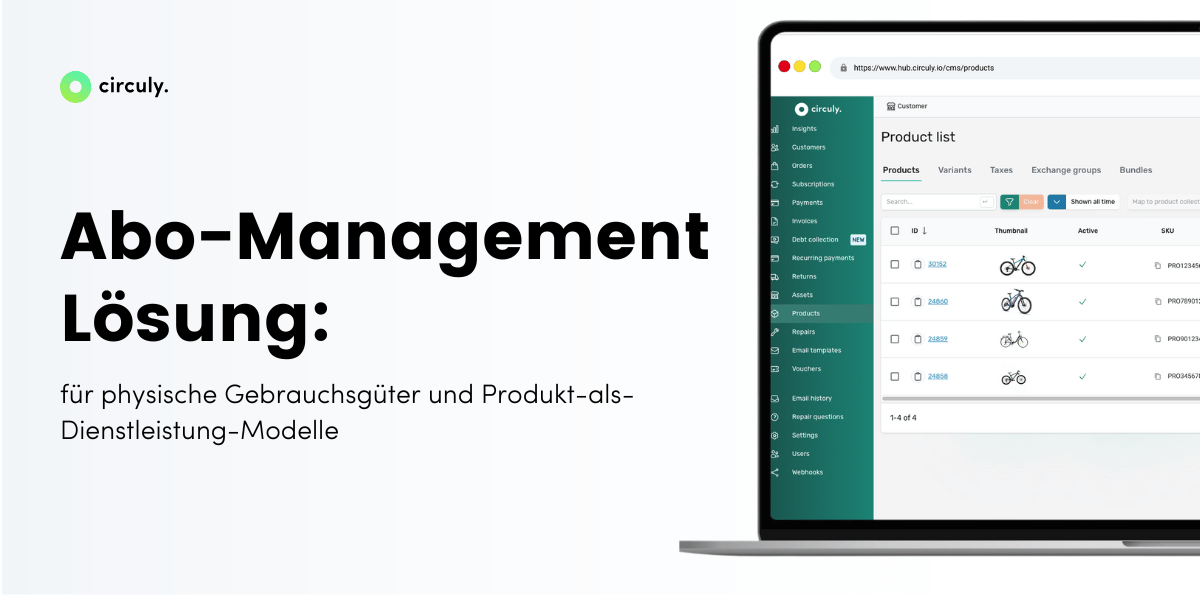E-commerce has trained customers to expect a smooth, almost invisible buying process: one-click checkout, same-day delivery, easy returns. Subscription-based eCommerce, however—especially in the world of physical consumer durable goods—often feels clunky by comparison. Account creation hurdles, unclear product conditions, hidden fees, or confusing policies can all discourage a first-time subscriber.
Yet the opportunity is clear. Subscriptions for furniture, appliances, electronics, or strollers are growing because they give customers flexibility without the burden of ownership. The challenge is creating a seamless journey that feels as effortless as buying a product online.
Here are four proven ways to make that happen.
1. Remove unnecessary friction in the sign-up flow
If a customer can purchase a €1,500 laptop online in less than a minute, they shouldn’t need 10 steps to rent it. Every additional form, mandatory account, or unclear process increases abandonment.
What to do:
- Allow guest checkout (no forced account creation).
- Localise key elements: currency, language, shipping methods, and payment providers that are familiar in the customer’s market. A family in Denmark expects Klarna; a student in Germany expects SEPA direct debit.
- Be transparent about subscription requirements upfront (e.g., credit check, ID verification). Customers accept them if they know in advance; they abandon if they discover them only at the final step.
2. Explain the value of pre-loved and refurbished products
In subscription models, customers often encounter second-hand or refurbished products. Unlike traditional retail, where “new” is the default, subscribers need reassurance about what they’re getting.
What to do:
- Provide a condition score or grading chart (e.g., “A – like new, B – minor scratches, C – signs of wear but fully functional”).
- Explain refurbishment processes: cleaning, safety checks, replacement of critical components.
3. Be transparent about pricing and add-ons
One of the top reasons for cart abandonment in eCommerce is unexpected costs at checkout. In subscriptions, the risk is even higher because of recurring payments and optional add-ons (e.g., insurance, accessories, delivery upgrades).
What to do:
- Show the impact of add-ons immediately on the product page or in the cart. Don’t wait until the final checkout screen.
- Provide a clear monthly cost breakdown: base subscription, add-ons, shipping, and one-time setup (if any).
- Use price simulations (e.g., “Total: €49/month with insurance, €39/month without”).
4. Address key concerns early and often
Buying is simple: you pay, you receive, you own. Subscribing, especially for the first time, raises more questions. Customers wonder:
- When do payments start—on delivery or immediately?
- What is the minimum subscription period?
- How do I cancel?
- What happens if something breaks?
Leaving these questions unanswered until the terms and conditions (or worse, customer support) creates anxiety and discourages conversions.
What to do:
- Create a clear “How It Works” page with visuals, step-by-step explanations, and FAQs.
- Place essential policies directly on product and checkout pages (e.g., “Cancel anytime after 3 months” or “Payment starts only upon delivery”).
- Use tooltips or expandable FAQs where customers need them most—on the cart and checkout page.
Bonus tips
- Start-Date Picker at Checkout: Allow customers to choose when the subscription should begin. This gives them flexibility and eliminates uncertainty.
- Damage Protection Explained in Plain Language: If you offer insurance or a damage waiver, explain clearly what is covered, what is not, and the exact monthly impact. Use simple scenarios to illustrate coverage.
- Bundle Recommendations That Reduce Effort: Suggest bundles that solve a complete need. For example, a bike can be offered together with a helmet and lock, or a stroller with a rain cover. Showing the total monthly price upfront makes the value visible and prevents surprises.
- Sizing and Fit Guidance: Help customers check fit and usability before delivery. For children’s products, for example, show how a stroller fits through standard doors or how a crib fits in a small room.
- Real Photos of Typical Wear by GradeIf you use condition grades for refurbished products, include real photos for each grade. This builds trust and helps customers choose with confidence.
- “How Returns Work” Module: Outline return scheduling, packaging expectations, and what happens after pickup. Customers should never be left guessing about the return process.
- First-Week Check-In: Send an automated message a few days after delivery with care tips and an easy way to request help. It prevents small issues from turning into cancellations.
- Soft Dunning with Friendly Recovery Paths: When a payment fails, retry through multiple payment methods and notify the customer with clear, supportive language. Keep resolution simple and stress-free.
- End-of-Term Options Shown from Day One: Display renewal, swap, upgrade, or buy-out options early so customers can plan ahead. This is especially important for fast-changing products like bikes, laptops, or baby gear.
- Compare Subscription vs. Ownership: Offer a simple comparison showing what it costs to subscribe versus buying outright. This helps customers see the financial and flexibility advantages of subscribing.
- Self-Service Portal for Customers: Provide a portal where customers can reschedule deliveries, request repairs, add accessories, update payment details, and download invoices without needing to contact support.



%20(25).png)
%20(24).png)





.png)





